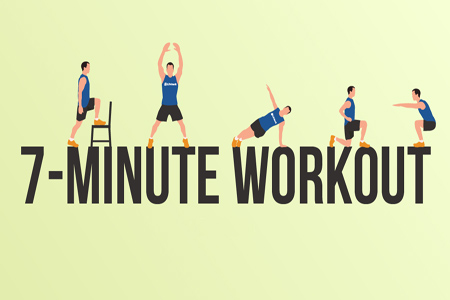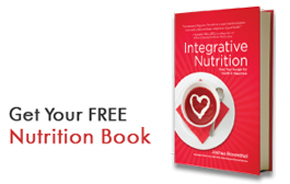I read this article written by an American doctor working in Beijing and have found it a fantastic resource for anybody who doesn’t like the gym or can’t find any free time to exercise! All it takes is 7 minutes and all you need is a chair! How about that? Read more on the science and medical benefits of this speedy routine below and download the PDF help sheet (detailing the 12 different exercises that you need to complete) at the bottom of the page. It really is that simple and trust me, when you do it, you feel it!
A 7 Minute Workout That Really Works
“Maximum Results With Minimal Investment”. It sounds like a shady late night infomercial, but it’s actually the subtitle of a well publicized review article from the May-June issue of the American College of Sports Medicine’s Health & Fitness Journal. Titled High Intensity Circuit Training Using Body Weight, it’s making worldwide headlines, especially after the New York Times picked up on it. It discusses the hot topic of high intensity interval training, which essentially means a very short burst of intense exercise plus quick breaks. So instead of the recommended 150 minutes a week of moderate exercise or 90 minutes of strong exercise, you could spend 15 of HIIT, three times a week – and get similar health benefits.
Let’s step back a minute and review the benefits of exercise. Most guidelines, including those from the U.S. CDC, recommend a combination of aerobic activity and muscle strengthening activity based on extensive research showing strong evidence of exercise lowering risks of early death; coronary heart disease; strokes; high blood pressure; diabetes; colon and breast cancer, among others. Even 90 minutes of moderate exercise lowers your risk of premature death by 20%; more is better but the effects start to tail off after 300 minutes, maxing out at 40% reduction.
But very few of us achieve even 30 minutes a week, much less the 90 or 150 minutes recommended. Physical inactivity is one of the world’s leading risk factors for disease, ranked #6 in the USA and #10 in China. That’s why any research showing benefits with less time committment is crucial for our modern societies, all increasingly less active. HIIT got its first boost in 1996 when a Japanese research team led by Professor Izumi Tabata compared moderate intensity training of 60 minutes versus a 4 minute high intensity training on stationary bikes. The HIIT group not only had a similar increase in aerobic activity but also had a much better improvement in anaerobic activity. One study published in 2011 from the Department of Kinesiology and Health Education, Southern Illinois University tested overweight college students and found that just one 15 minute session of high intensity activity changed their resting energy expenditure (metabolic rate) for 72 hours. This was just as effective as a more routine 35 minute workout. Another study from the Faculty of Medicine, University of New South Wales showed that a 15 minute HIIT workout three times a week, compared to more traditional longer workouts, actually had better outcomes losing total body fat as well as insulin resistance. I consider these latter improvements very significant as diabetes continues to skyrocket right along with obesity in most countries.
When it comes to exercise, I confess I am much more sloth-like than a fitness freak, so I love the idea of a quick fix for health which actually works. I first heard about HIIT last autumn and started to do a 5 minute routine each morning. I went all out for 30 seconds performing as many squat thrusts as I could, then took 10 second breaks, then repeated 10 times for a total of 5 minutes. I confess that I stopped this routine after a month, as I do with most of my ambitions for exercise. But I definitely had felt stronger and more alert during those weeks, and I certainly felt that achy muscle sensation after these sessions. Last week I started this newly publicized 7 minute routine, combining 30 second intervals with circuit training. With circuit training, you rotate your exercises between focused muscle groups, and finishing the entire routine ideally will have covered all muscle groups. You can choose any exercises for HIIT, but one additional benefit of this particular cycle is that you don’t need any weights or machines, just your own body, a wall and a chair. You can perform this anywhere, from your hotel room to your office and home. There’s an image of the routine on the New York Times page.
Each exercise should be done for 30 seconds, with 10 seconds of rest in between, for a total of 7 minutes and 30 seconds. You could also repeat this cycle one of two more times for added benefit. It’s important to take these very short breaks as it increases the healthy metabolic response. You will definitely need help keeping track of these seconds, and I found a wide collection of apps for smartphones and tablets which can be custom set to beep at the correct intervals. Just search your app store for HIIT, Tabata or “interval timer” and take your pick.
The key here is to really push yourself, not take a leisurely pace. In terms of intensity, most of these research papers’ recommendations mention “unpleasant” or “discomforting”. Many papers also mention something called VO2max, which is officially measured using oxygen sensor machines but otherwise generally correlates to 100% of your maximum heart rate. Thus we all should know our maximum heart rate, and fortunately this is easy to calculate. You can find online calculators, otherwise you can do the calculation yourself. The formula for maximum workout heart rate, calculated in a 2001 research paper, = 208 – .7 * age. For example, I am 45 years old and my maximum heart rate (VO2max) is 208 -.7*45 = 177 beats per minute. If I wanted to reach the 150 minutes a week goal of moderate exercise, my target heart rate for moderate exercise would be 60% of max: 0.6 x 177 = 106 beats per minute. The recommended target for more intense exercise is 80% of max, which for me is 142. I usually get up to this rate with a thirty minute treadmill or elliptical machine workout, and quite honestly it didn’t feel too uncomfortable at all. For the more aggressive HIIT therapy, shooting for 90-100% maximum heart rate works out to 159-177 beats per minute. After I performed the above routine I definitely felt a bit “unpleasant” with a pulse of over 160 — exactly where I should be.
So now I’ve finally run out of excuses for not exercising. I can simply get up 10 minutes earlier each day or just be more efficient in the morning, and perform one or two cycles of this routine, ideally three times a week. Add this to my bicycling to and from my clinic and I can finally hold my head up high when I give my standard lifestyle lecture to my patients.
I think this type of evidence-based exercise research is powerful and certainly has altered my usual speech to patients. I previously would always mention the usual recommended minutes of exercise (150 moderate, 90 intense) but now can make it even more appealing: 15 minutes, three times a week. Certainly this wouldn’t appeal to people who already exercise or play sports. And data is still lacking on the long-term benefits and risk reductions from HIIT. But for the silent majority like myself who do almost no activity, HIIT routines are clearly far better than nothing, and could save millions of lives worldwide.










Leave A Response